NISSAN X-TRAIL 2001 Service Repair Manual
Manufacturer: NISSAN, Model Year: 2001, Model line: X-TRAIL, Model: NISSAN X-TRAIL 2001Pages: 3833, PDF Size: 39.49 MB
Page 3451 of 3833
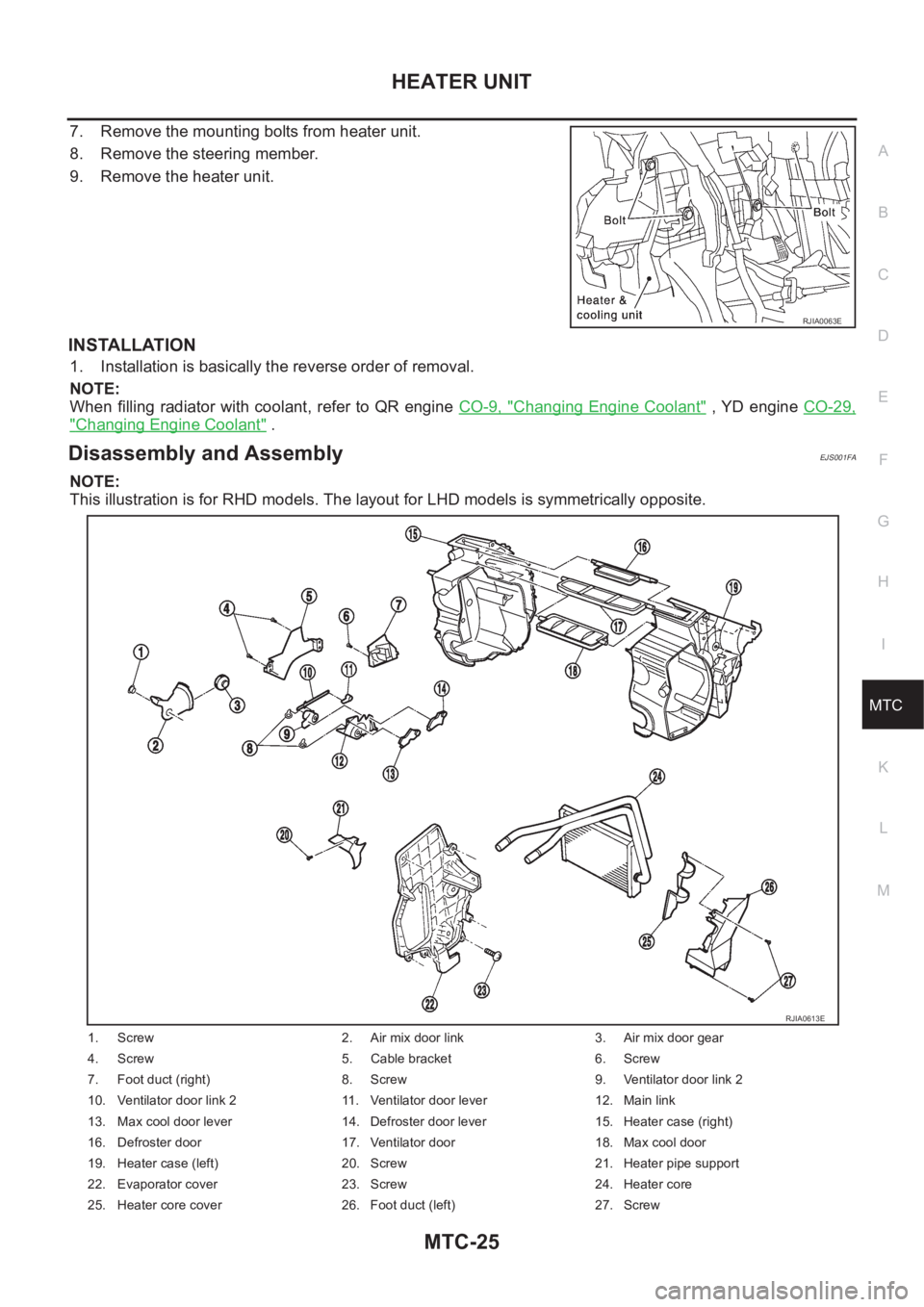
HEATER UNIT
MTC-25
C
D
E
F
G
H
I
K
L
MA
B
MTC
7. Remove the mounting bolts from heater unit.
8. Remove the steering member.
9. Remove the heater unit.
INSTALLATION
1. Installation is basically the reverse order of removal.
NOTE:
When filling radiator with coolant, refer to QR engine CO-9, "
Changing Engine Coolant" , YD engine CO-29,
"Changing Engine Coolant" .
Disassembly and AssemblyEJS001FA
NOTE:
This illustration is for RHD models. The layout for LHD models is symmetrically opposite.
RJIA0063E
1. Screw 2. Air mix door link 3. Air mix door gear
4. Screw 5. Cable bracket 6. Screw
7. Foot duct (right) 8. Screw 9. Ventilator door link 2
10. Ventilator door link 2 11. Ventilator door lever 12. Main link
13. Max cool door lever 14. Defroster door lever 15. Heater case (right)
16. Defroster door 17. Ventilator door 18. Max cool door
19. Heater case (left) 20. Screw 21. Heater pipe support
22. Evaporator cover 23. Screw 24. Heater core
25. Heater core cover 26. Foot duct (left) 27. Screw
RJIA0613E
Page 3452 of 3833
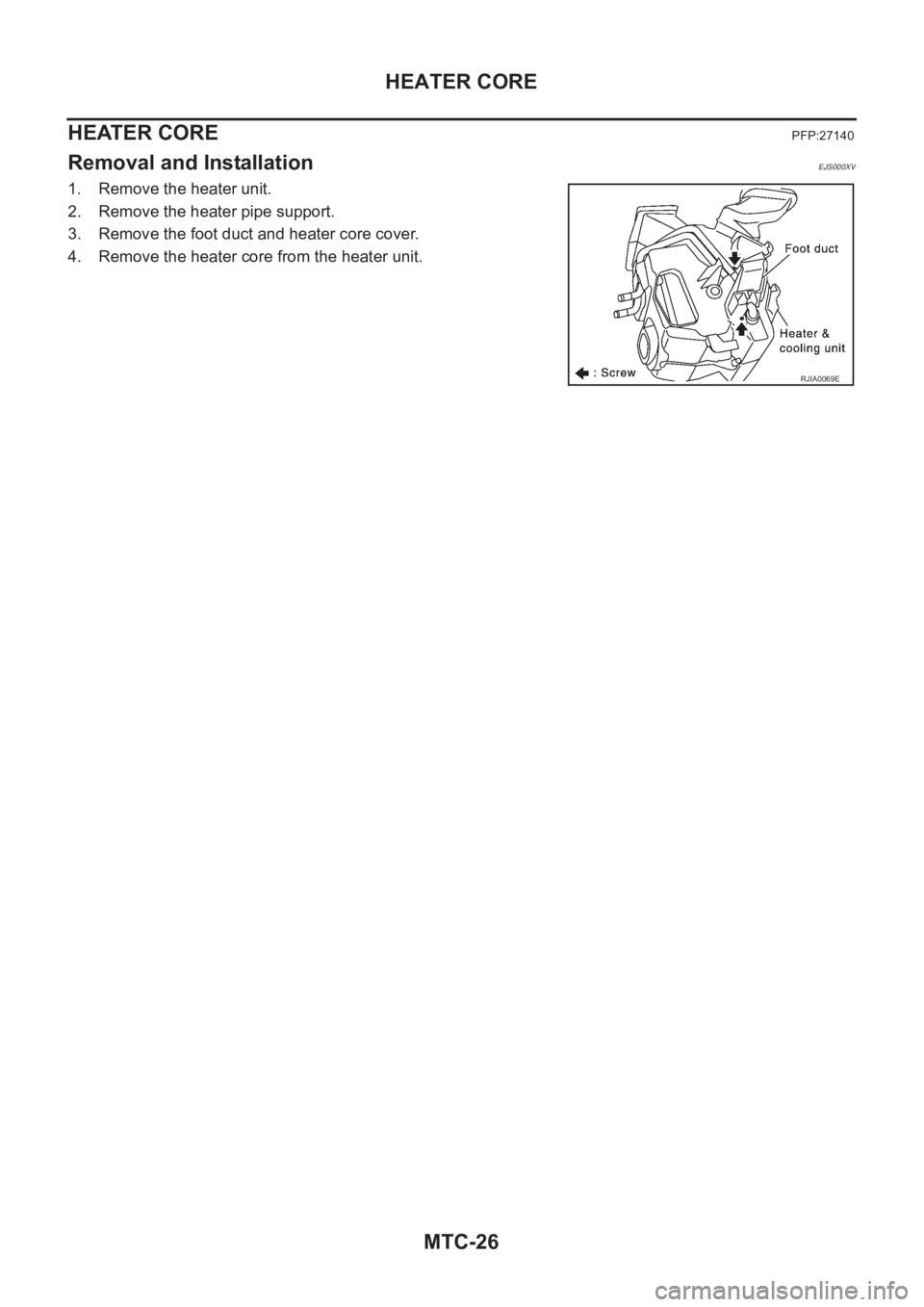
MTC-26
HEATER CORE
HEATER CORE
PFP:27140
Removal and InstallationEJS000XV
1. Remove the heater unit.
2. Remove the heater pipe support.
3. Remove the foot duct and heater core cover.
4. Remove the heater core from the heater unit.
RJIA0069E
Page 3453 of 3833
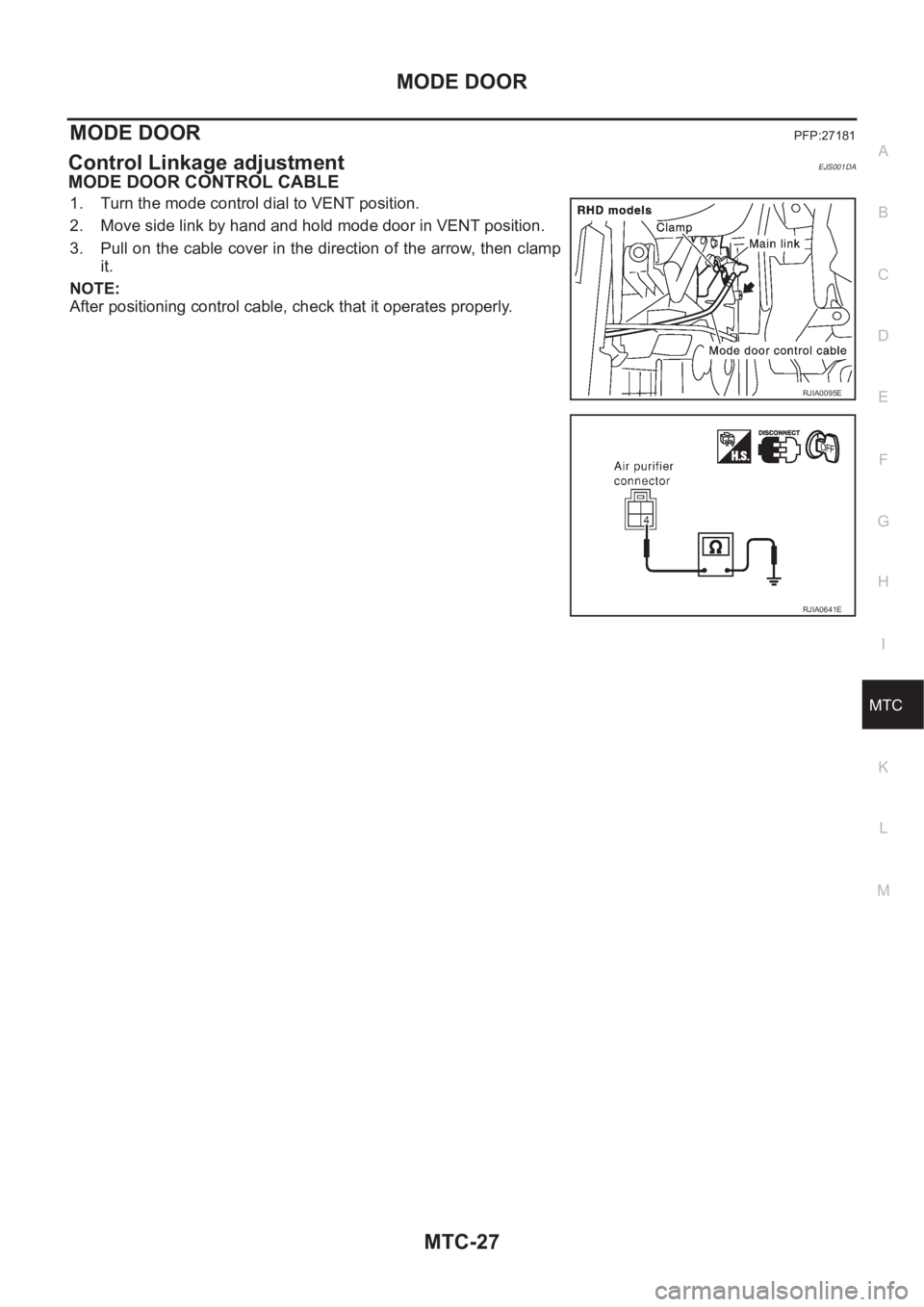
MODE DOOR
MTC-27
C
D
E
F
G
H
I
K
L
MA
B
MTC
MODE DOORPFP:27181
Control Linkage adjustmentEJS001DA
MODE DOOR CONTROL CABLE
1. Turn the mode control dial to VENT position.
2. Move side link by hand and hold mode door in VENT position.
3. Pull on the cable cover in the direction of the arrow, then clamp
it.
NOTE:
After positioning control cable, check that it operates properly.
RJIA0095E
RJIA0641E
Page 3454 of 3833
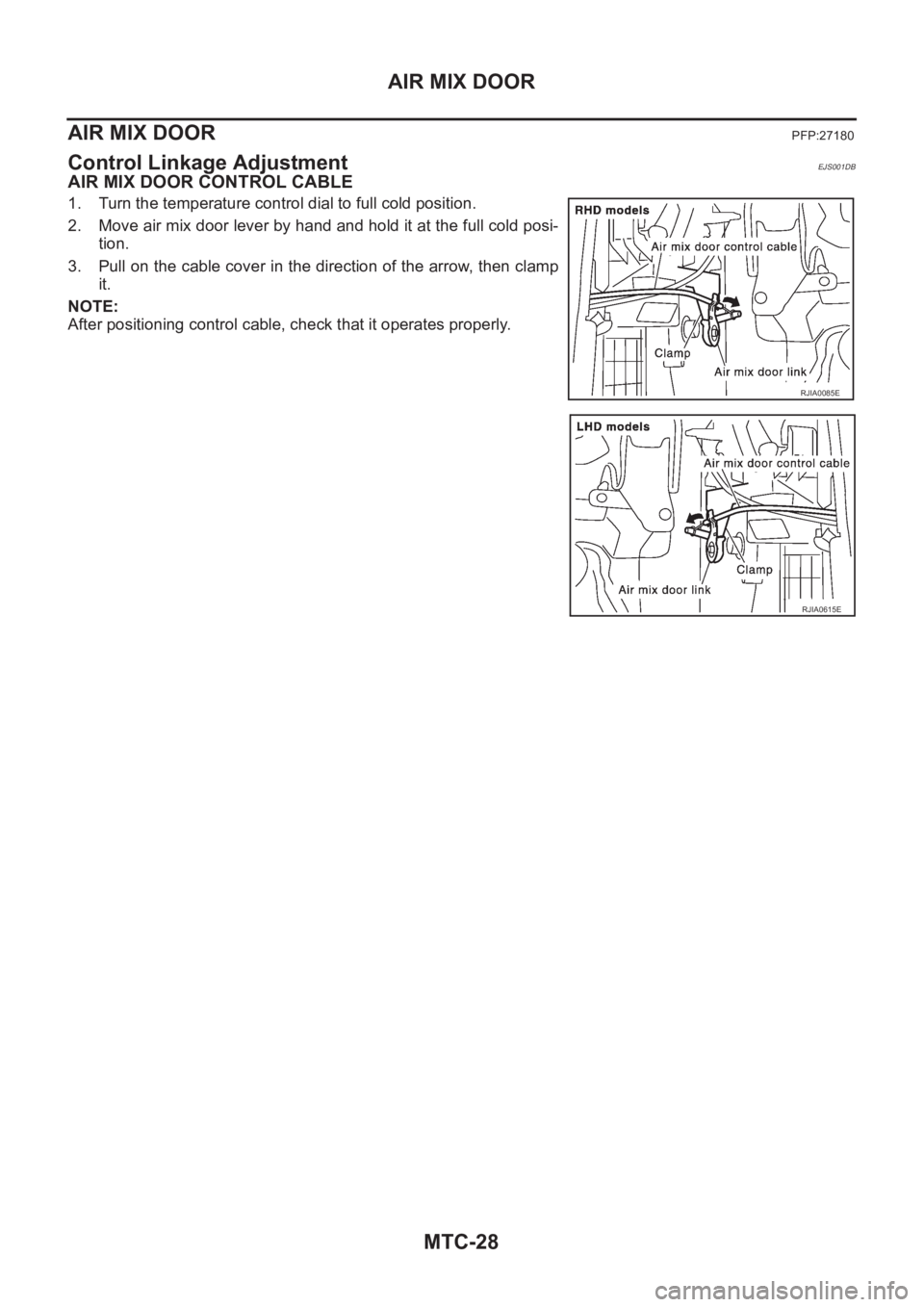
MTC-28
AIR MIX DOOR
AIR MIX DOOR
PFP:27180
Control Linkage AdjustmentEJS001DB
AIR MIX DOOR CONTROL CABLE
1. Turn the temperature control dial to full cold position.
2. Move air mix door lever by hand and hold it at the full cold posi-
tion.
3. Pull on the cable cover in the direction of the arrow, then clamp
it.
NOTE:
After positioning control cable, check that it operates properly.
RJIA0085E
RJIA0615E
Page 3455 of 3833
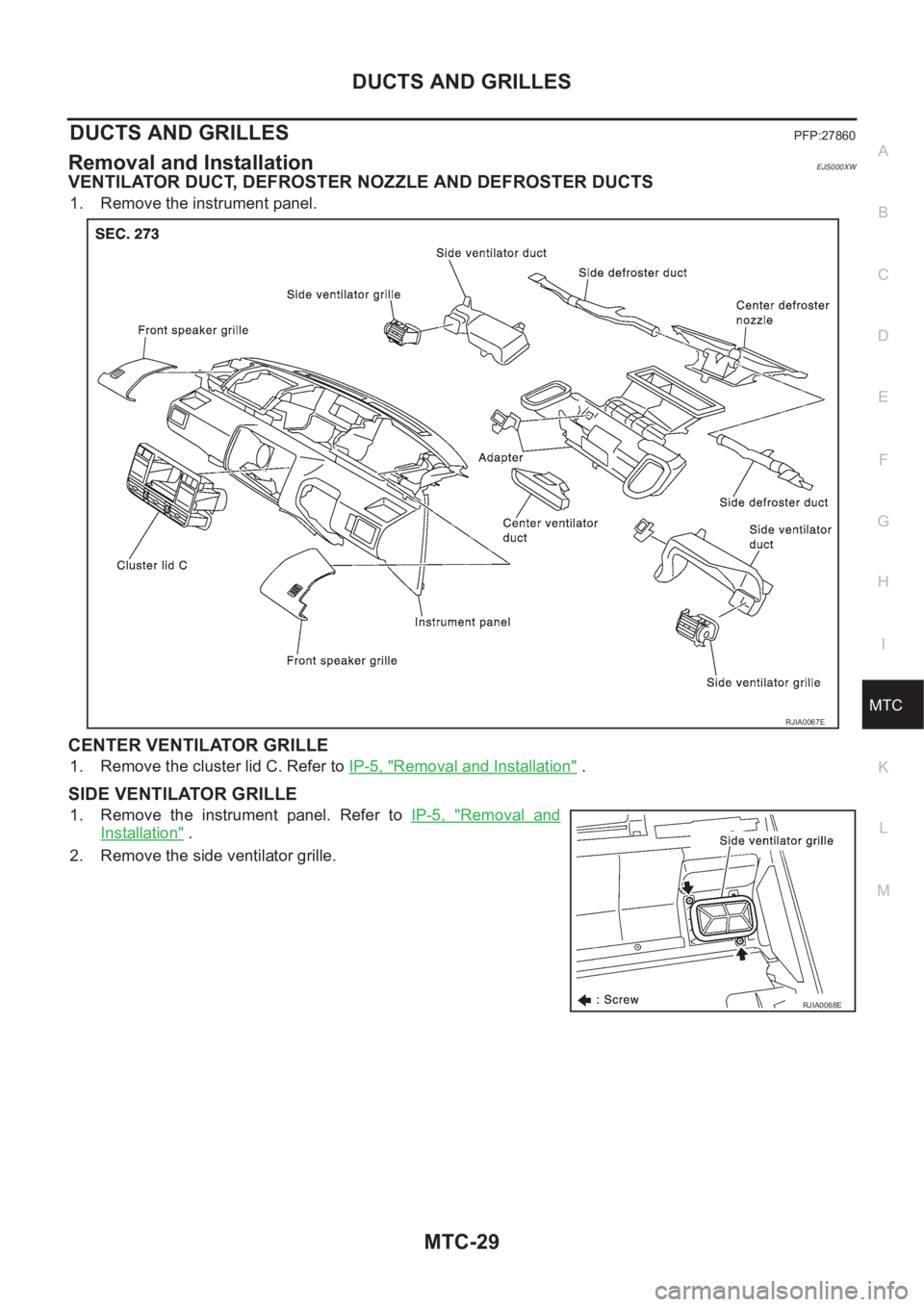
DUCTS AND GRILLES
MTC-29
C
D
E
F
G
H
I
K
L
MA
B
MTC
DUCTS AND GRILLESPFP:27860
Removal and InstallationEJS000XW
VENTILATOR DUCT, DEFROSTER NOZZLE AND DEFROSTER DUCTS
1. Remove the instrument panel.
CENTER VENTILATOR GRILLE
1. Remove the cluster lid C. Refer to IP-5, "Removal and Installation" .
SIDE VENTILATOR GRILLE
1. Remove the instrument panel. Refer to IP-5, "Removal and
Installation" .
2. Remove the side ventilator grille.
RJIA0067E
RJIA0068E
Page 3456 of 3833
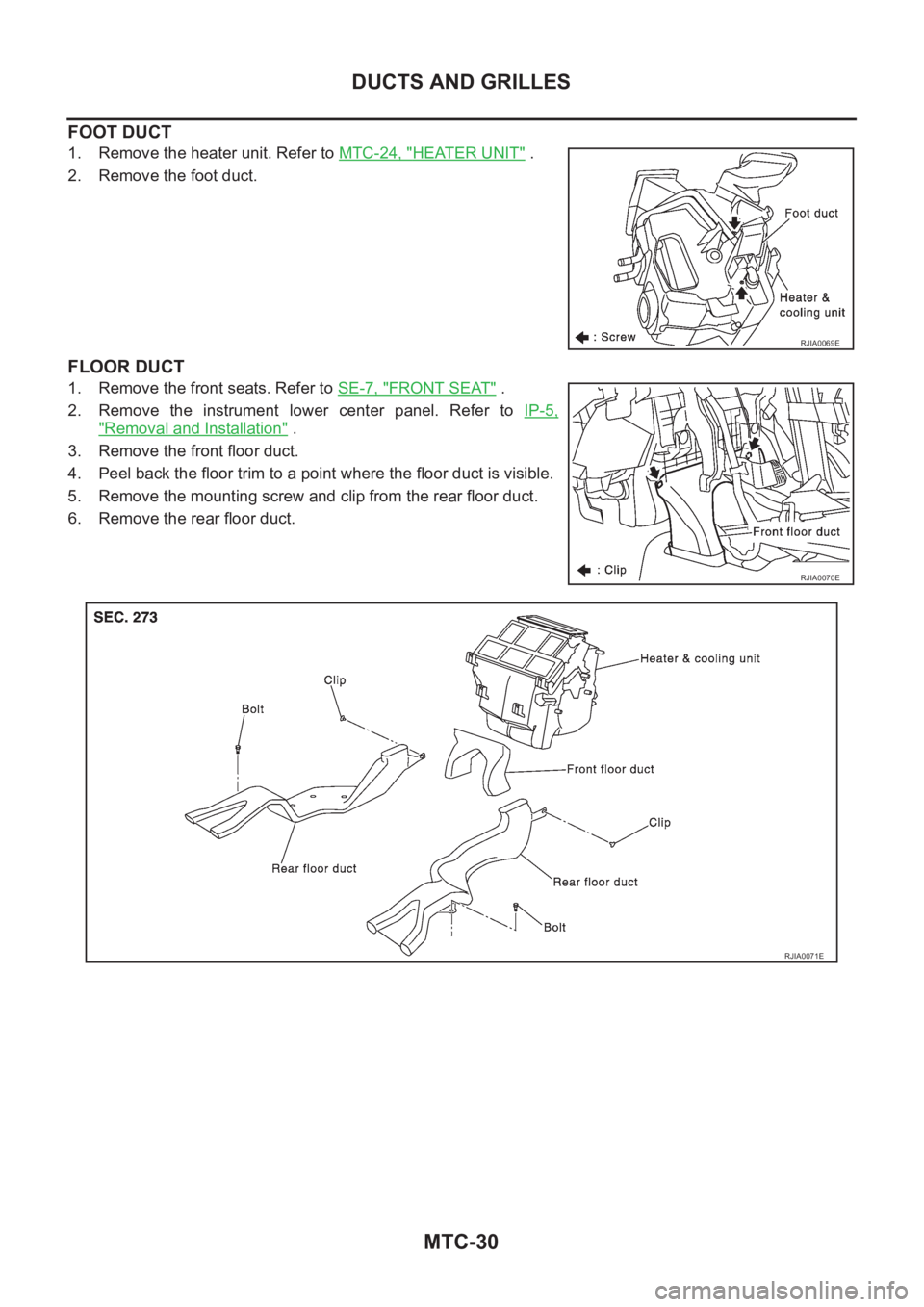
MTC-30
DUCTS AND GRILLES
FOOT DUCT
1. Remove the heater unit. Refer to MTC-24, "HEATER UNIT" .
2. Remove the foot duct.
FLOOR DUCT
1. Remove the front seats. Refer to SE-7, "FRONT SEAT" .
2. Remove the instrument lower center panel. Refer to IP-5,
"Removal and Installation" .
3. Remove the front floor duct.
4. Peel back the floor trim to a point where the floor duct is visible.
5. Remove the mounting screw and clip from the rear floor duct.
6. Remove the rear floor duct.
RJIA0069E
RJIA0070E
RJIA0071E
Page 3457 of 3833
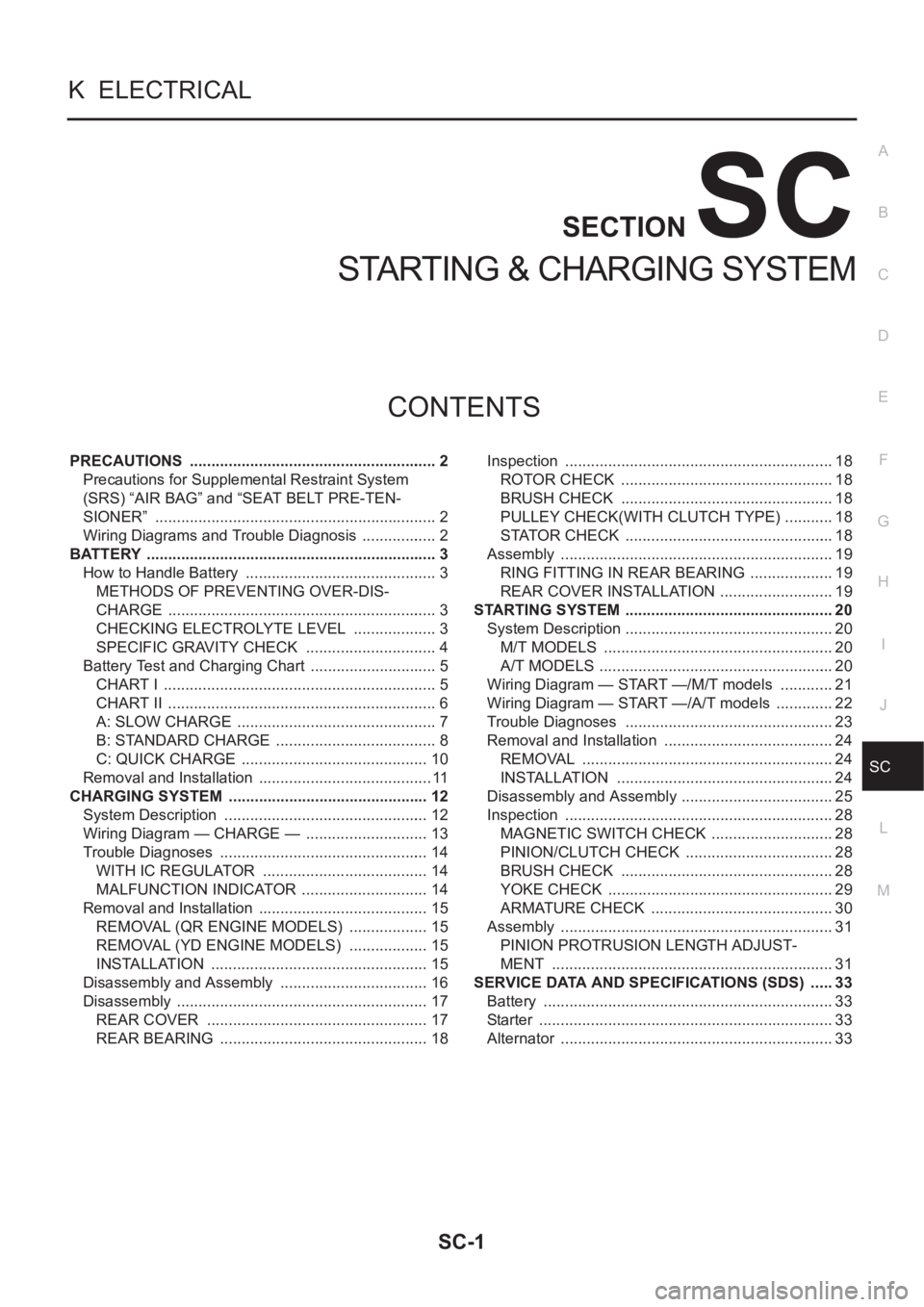
SC-1
STARTING & CHARGING SYSTEM
K ELECTRICAL
CONTENTS
C
D
E
F
G
H
I
J
L
M
SECTION
A
B
SC
STARTING & CHARGING SYSTEM
PRECAUTIONS .......................................................... 2
Precautions for Supplemental Restraint System
(SRS) “AIR BAG” and “SEAT BELT PRE-TEN-
SIONER” .................................................................. 2
Wiring Diagrams and Trouble Diagnosis .................. 2
BATTERY .................................................................... 3
How to Handle Battery ............................................. 3
METHODS OF PREVENTING OVER-DIS-
CHARGE ............................................................... 3
CHECKING ELECTROLYTE LEVEL .................... 3
SPECIFIC GRAVITY CHECK ............................... 4
Battery Test and Charging Chart .............................. 5
CHART I ................................................................ 5
CHART II ............................................................... 6
A: SLOW CHARGE ............................................... 7
B: STANDARD CHARGE ...................................... 8
C: QUICK CHARGE ............................................ 10
Removal and Installation ......................................... 11
CHARGING SYSTEM ............................................... 12
System Description ................................................ 12
Wiring Diagram — CHARGE — ............................. 13
Trouble Diagnoses ................................................. 14
WITH IC REGULATOR ....................................... 14
MALFUNCTION INDICATOR .............................. 14
Removal and Installation ........................................ 15
REMOVAL (QR ENGINE MODELS) ................... 15
REMOVAL (YD ENGINE MODELS) ................... 15
INSTALLATION ................................................... 15
Disassembly and Assembly ................................... 16
Disassembly ........................................................... 17
REAR COVER .................................................... 17
REAR BEARING ................................................. 18Inspection ............................................................... 18
ROTOR CHECK .................................................. 18
BRUSH CHECK .................................................. 18
PULLEY CHECK(WITH CLUTCH TYPE) ............ 18
STATOR CHECK ................................................. 18
Assembly ................................................................ 19
RING FITTING IN REAR BEARING .................... 19
REAR COVER INSTALLATION ........................... 19
STARTING SYSTEM ................................................. 20
System Description ................................................. 20
M/T MODELS ...................................................... 20
A/T MODELS ....................................................... 20
Wiring Diagram — START —/M/T models ............. 21
Wiring Diagram — START —/A/T models .............. 22
Trouble Diagnoses ..............................................
... 23
Removal and Installation ........................................ 24
REMOVAL ........................................................... 24
INSTALLATION ................................................... 24
Disassembly and Assembly .................................... 25
Inspection ............................................................... 28
MAGNETIC SWITCH CHECK ............................. 28
PINION/CLUTCH CHECK ................................... 28
BRUSH CHECK .................................................. 28
YOKE CHECK ..................................................... 29
ARMATURE CHECK ........................................... 30
Assembly ................................................................ 31
PINION PROTRUSION LENGTH ADJUST-
MENT .................................................................. 31
SERVICE DATA AND SPECIFICATIONS (SDS) ...... 33
Battery .................................................................... 33
Starter ..................................................................... 33
Alternator ................................................................ 33
Page 3458 of 3833
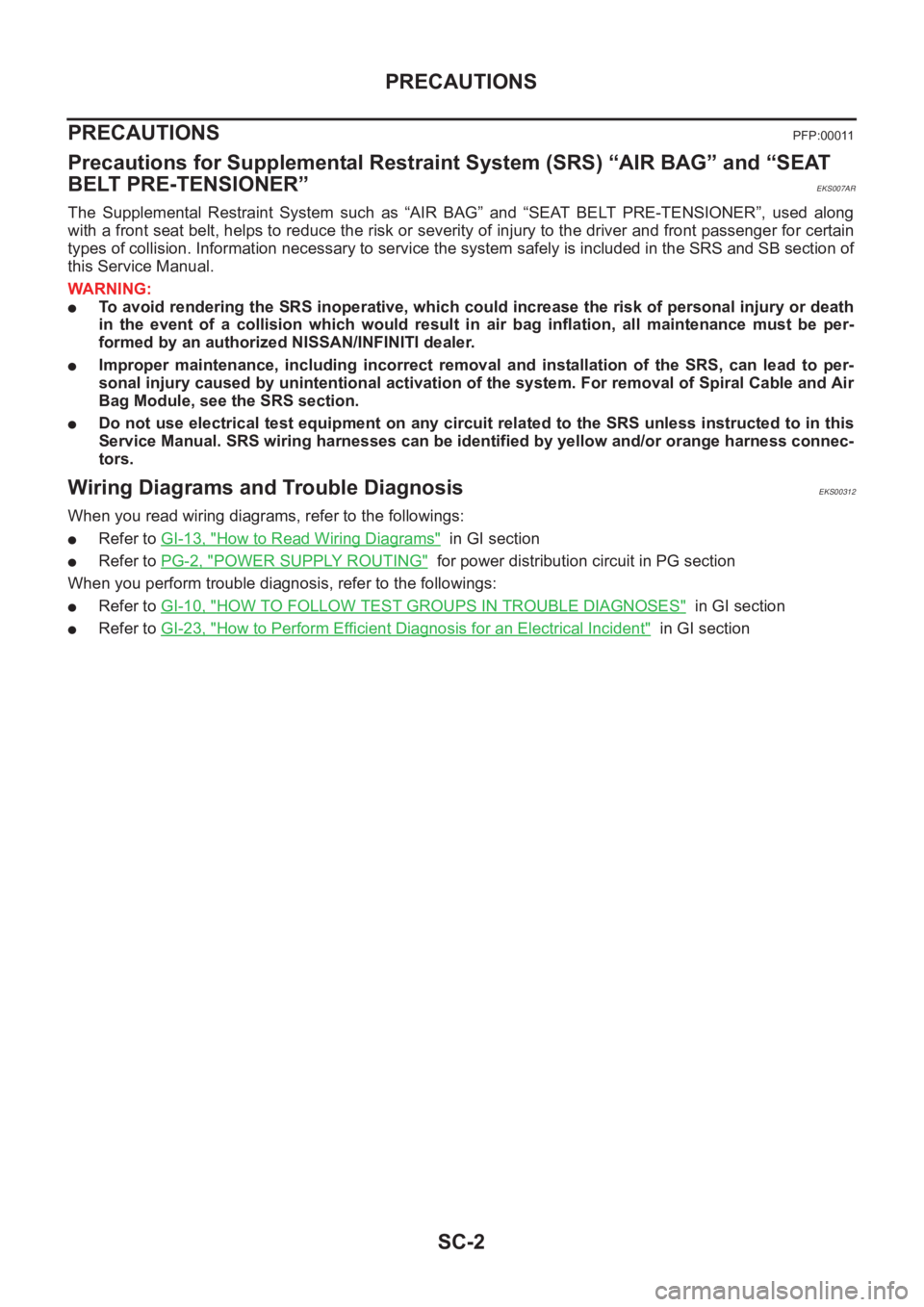
SC-2
PRECAUTIONS
PRECAUTIONS
PFP:00011
Precautions for Supplemental Restraint System (SRS) “AIR BAG” and “SEAT
BELT PRE-TENSIONER”
EKS007AR
The Supplemental Restraint System such as “AIR BAG” and “SEAT BELT PRE-TENSIONER”, used along
with a front seat belt, helps to reduce the risk or severity of injury to the driver and front passenger for certain
types of collision. Information necessary to service the system safely is included in the SRS and SB section of
this Service Manual.
WARNING:
●To avoid rendering the SRS inoperative, which could increase the risk of personal injury or death
in the event of a collision which would result in air bag inflation, all maintenance must be per-
formed by an authorized NISSAN/INFINITI dealer.
●Improper maintenance, including incorrect removal and installation of the SRS, can lead to per-
sonal injury caused by unintentional activation of the system. For removal of Spiral Cable and Air
Bag Module, see the SRS section.
●Do not use electrical test equipment on any circuit related to the SRS unless instructed to in this
Service Manual. SRS wiring harnesses can be identified by yellow and/or orange harness connec-
tors.
Wiring Diagrams and Trouble Diagnosis EKS00312
When you read wiring diagrams, refer to the followings:
●Refer to GI-13, "How to Read Wiring Diagrams" in GI section
●Refer to PG-2, "POWER SUPPLY ROUTING" for power distribution circuit in PG section
When you perform trouble diagnosis, refer to the followings:
●Refer to GI-10, "HOW TO FOLLOW TEST GROUPS IN TROUBLE DIAGNOSES" in GI section
●Refer to GI-23, "How to Perform Efficient Diagnosis for an Electrical Incident" in GI section
Page 3459 of 3833
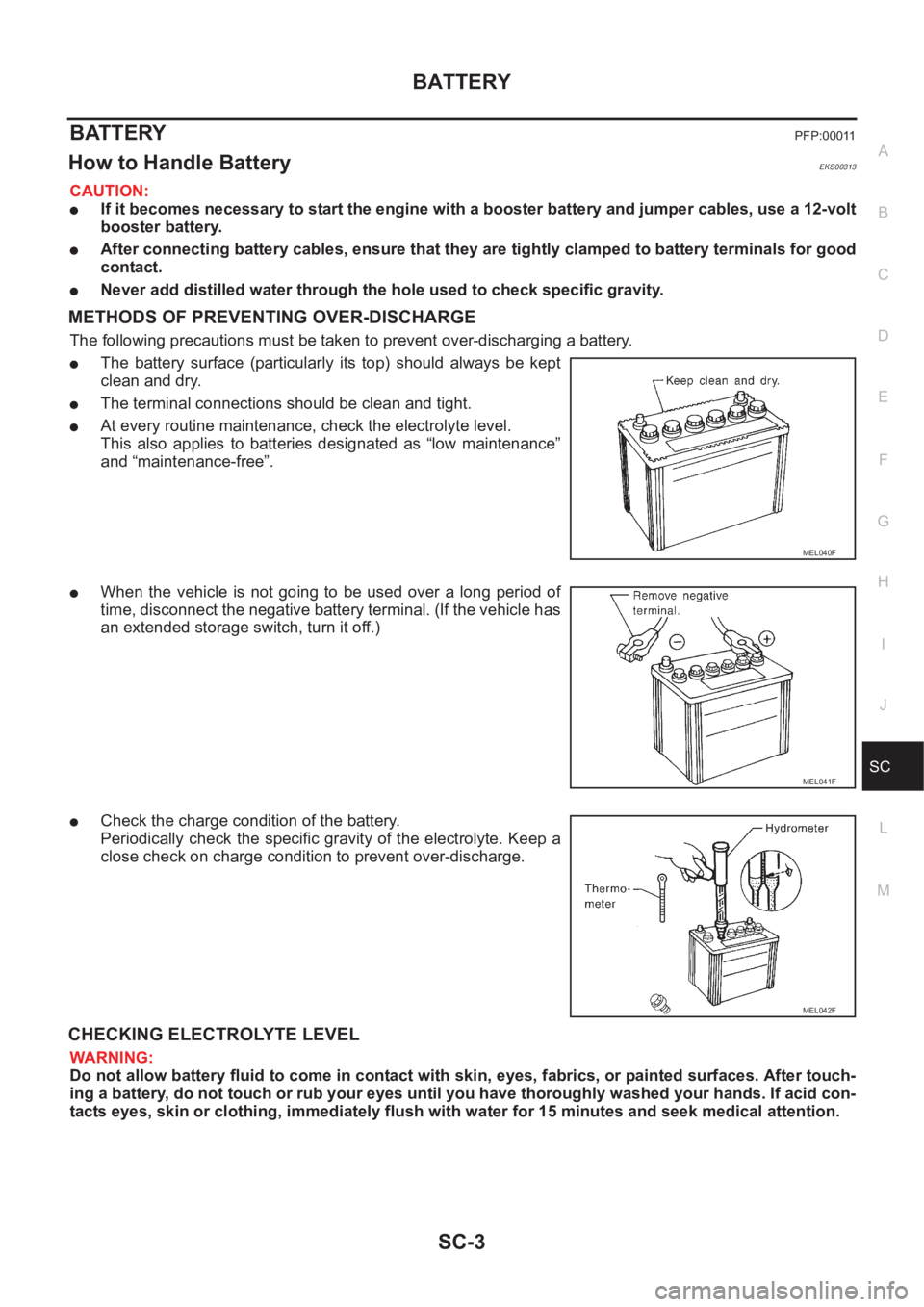
BATTERY
SC-3
C
D
E
F
G
H
I
J
L
MA
B
SC
BATTERY PFP:00011
How to Handle Battery EKS00313
CAUTION:
●If it becomes necessary to start the engine with a booster battery and jumper cables, use a 12-volt
booster battery.
●After connecting battery cables, ensure that they are tightly clamped to battery terminals for good
contact.
●Never add distilled water through the hole used to check specific gravity.
METHODS OF PREVENTING OVER-DISCHARGE
The following precautions must be taken to prevent over-discharging a battery.
●The battery surface (particularly its top) should always be kept
clean and dry.
●The terminal connections should be clean and tight.
●At every routine maintenance, check the electrolyte level.
This also applies to batteries designated as “low maintenance”
and “maintenance-free”.
●When the vehicle is not going to be used over a long period of
time, disconnect the negative battery terminal. (If the vehicle has
an extended storage switch, turn it off.)
●Check the charge condition of the battery.
Periodically check the specific gravity of the electrolyte. Keep a
close check on charge condition to prevent over-discharge.
CHECKING ELECTROLYTE LEVEL
WARNING:
Do not allow battery fluid to come in contact with skin, eyes, fabrics, or painted surfaces. After touch-
ing a battery, do not touch or rub your eyes until you have thoroughly washed your hands. If acid con-
tacts eyes, skin or clothing, immediately flush with water for 15 minutes and seek medical attention.
MEL040F
MEL041F
MEL042F
Page 3460 of 3833
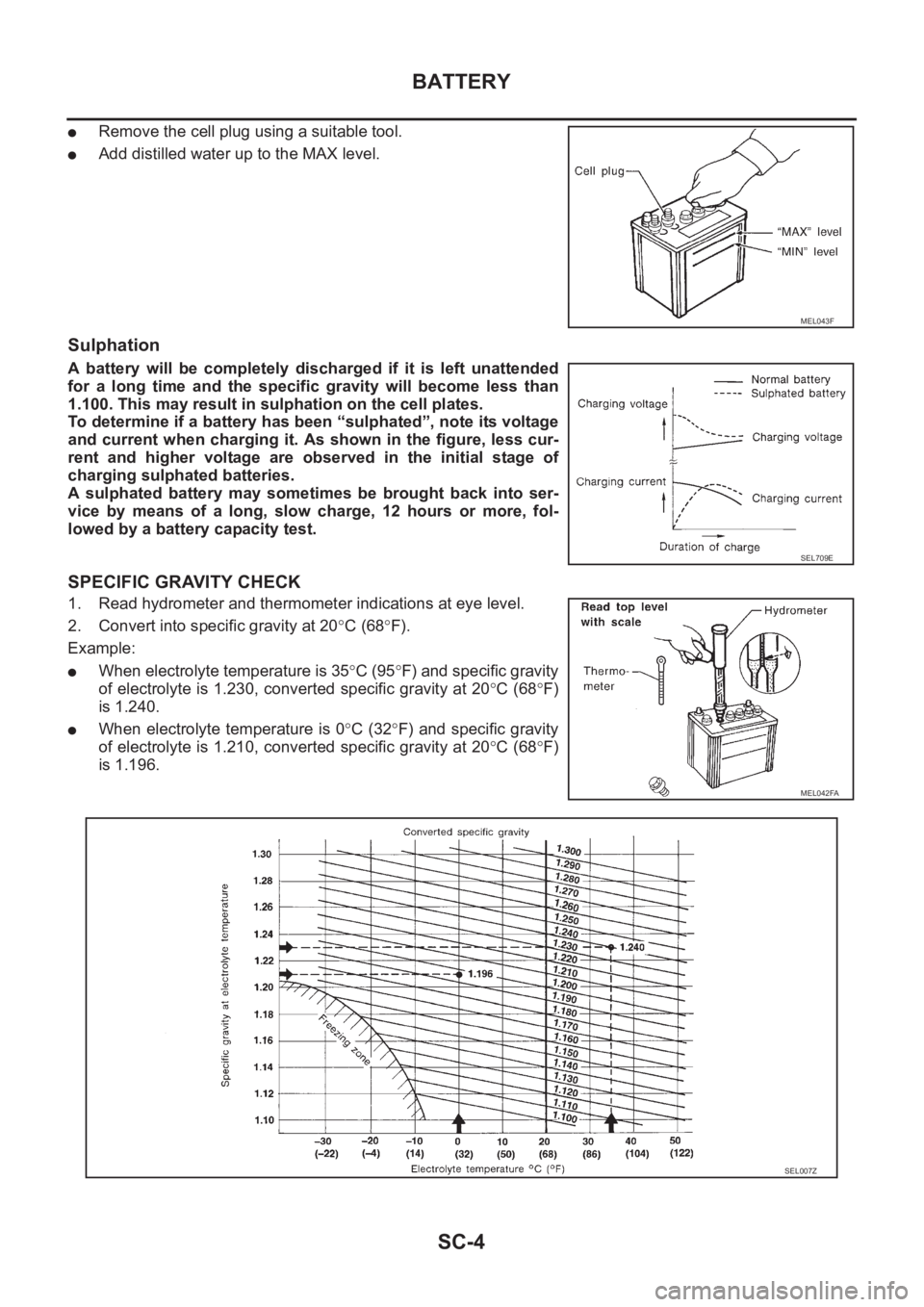
SC-4
BATTERY
●Remove the cell plug using a suitable tool.
●Add distilled water up to the MAX level.
Sulphation
A battery will be completely discharged if it is left unattended
for a long time and the specific gravity will become less than
1.100. This may result in sulphation on the cell plates.
To determine if a battery has been “sulphated”, note its voltage
and current when charging it. As shown in the figure, less cur-
rent and higher voltage are observed in the initial stage of
charging sulphated batteries.
A sulphated battery may sometimes be brought back into ser-
vice by means of a long, slow charge, 12 hours or more, fol-
lowed by a battery capacity test.
SPECIFIC GRAVITY CHECK
1. Read hydrometer and thermometer indications at eye level.
2. Convert into specific gravity at 20°C (68°F).
Example:
●When electrolyte temperature is 35°C (95°F) and specific gravity
of electrolyte is 1.230, converted specific gravity at 20°C (68°F)
is 1.240.
●When electrolyte temperature is 0°C (32°F) and specific gravity
of electrolyte is 1.210, converted specific gravity at 20°C (68°F)
is 1.196.
MEL043F
SEL709E
MEL042FA
SEL007Z